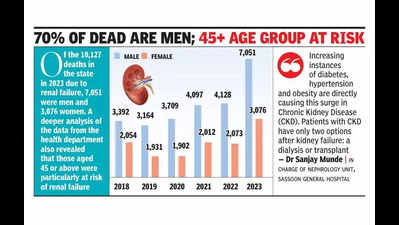
Pune: Between 2018 and 2023, deaths due to kidney failures doubled across Maharashtra, going up from 5,000 to 10,000 per year, health department data shows. In fact, within a single-year period, between 2022 and 2023, these deaths jumped 40%, showing just how alarmingly prevalent renal failure has become in the state. The data was analysed and verified by Maharashtra health department's Bureau of Health Intelligence Vital Statistics (SBHIVS).
"These are not deaths where kidney failure likely had a role. These are deaths which were the direct result of kidney failure," said Dr Rajratna Waghmare, deputy director of health services at SBHIVS, Pune. "So as per our trend analysis, we have essentially witnessed a rise in deaths that can be directly attributed to non-communicable diseases," he added.
Of the 10,127 people who died of renal failure in 2023 in the state, 70% of them, or 7,051, were men. Experts said the key reasons for this increase in renal failure deaths were the rise in non-communicable diseases such as diabetes and lack of access to dialysis or kidney transplants. A deeper study of the data also revealed that those aged 45 or above were particularly at risk of renal failure.
Of the 10,127 deaths, 1,753 were in the 45-54 age group; 2,398 were in the 55-64 group; 1,619 in the 65-74 group; and 2,466 in the 70-plus age group. Dr Sanjay Munde, in charge of the nephrology unit at Sassoon General Hospital, said admissions data has shown for some time that chronic kidney disease has been on the rise. He said: "In patients with CKD, myocardial infarction [a heart attack] is the most common cause of death.
Increasing instances of diabetes, hypertension and obesity are directly causing this surge in CKD and other renal ailments. Patients with CKD have only two options after kidney failure: a dialysis or transplant. And irrespective of the financial capacity, if a person is contraindicated with another ailment, they may be incapable of undergoing a kidney transplant, which is a major surgery.
In such a case, the only option left is dialysis for life." But despite this rise in kidney-related ailments, patients have not been receiving a proportionate improvement in care. The state govt-run Mahatma Jyotiba Phule Jan Arogya Yojana does cover the cost of dialysis, but not all hospitals are empaneled under this scheme, which restricts where a patient can receive regular dialysis.
Also, coverage for a kidney transplant procedure under the scheme is only till Rs 5 lakh, which is less than 50% of the total cost a patient may have to pay at a private hospital in a tier-1 city. Dr Abhijit More, a healthcare activist, said: "A CKD patient may need 2-3 dialysis services every week, depending on the condition. And each dialysis takes four hours to complete.
So a patient can lose a day's wage and may also need an assistant who too may lose a day's salary. All this makes the procedure very challenging." He added: "In addition to having a dialysis centre at every sub-district hospital, the government could also start mobile dialysis centres that can, for instance, provide doorstep services in villages.
These are workable solutions.".














